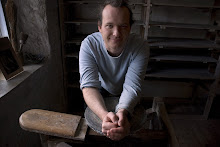Porcelain is a funny material at best and takes some getting used to. It shinks a lot while it dryes and shrinks even more when fired. The final result can look as much a 40% smaller than when it was thrown. Warping is also something to look out for.
Together with the help of fellow potter Russell Gibbs we managed to make a fair number of these largish jars out of 'Ming Porcelain'.
The porcelain was devised by Scarva pottery supplies in Ireland, they are passionate about clays and their properties, in their pottery-lab they came up with this 'Ancient Ming reciepe' after much research on ancient asian porcelains
This porcelain, I dirtied it ever so slightly with a bit of cornish iron- fire clay.
The glaze formula I use is a revival of a very old glaze called SUI, for it made its first appearance in the Sui and Tang dynasties (580 - 940).
The trouble with wanting to make 'replicas' of ancient ceramics is that one often tries too hard, focusing on the form and neglecting the clay body.
Many Celadons I have seen are so pure, the body so white it looks contemporary.
Maybe it is our western or modern mindset of wanting to recreate the 'purest' porcelain.
The 17th century up to today has seen the flourishing of millions of 'export' porcelains, often excellently decorated.
Most of the time these leave me cold.
Personally I prefer the older porcelains, such as the Korean Chosuns, the Quing Bai's, Yue, Kuans, Long kuans; often made with only partly refined natural china Clay , china stone and sometimes even with a bit of red (terraccota like) clay added in!
Chinese and Korean potters knew what they were doing, they like us mixed different clays and stones together in order to get closer to the desired effect.
The magic was in the form, yes but also in the clay body, how it interplayed with the glaze; the way it was fired, the way it was cooled etc.. Not to forget their own unique experience and conciousness at the time, something we will never have..;
I feel Obsessive and passionate about the mysteries of oriental ceramics, yet I am no archeologist, I am no historian or physicist.
I just am inspired to create and interpret tradition, it is an adventure rather than a set challenge.
For instance the handles on the lid of this pot are not traditional -they are made up.
I think I was thinking of caterpillars walking...
Large Tea jar or Small Water jar?
Inscription à :
Publier les commentaires (Atom)




4 commentaires:
Dear Michel,
I am a fan!
What is your experience with water ageing jars?
All the Best,
Jason
Hello Jason
To be frank I have not had time yet to test these jars.
I have been interested in water and how the raw materials in clays and glazes affect the taste of Tea for about 5 years. Then adapting this to what materials I can lay my hands on.
I am very happy with the qualities of porcelains and especially my izu glaze made with special feldspar and cornish stone, which I use to glaze my teacups with, they really work with tea>
Dear Michel,
Do let me know what you find.
I may be looking for a water ageing jar in the near future...!
All the Best,
Jason
Dear Michel,
Do you have any updates on using this jar for water ageing?
I am still contemplating purchasing this if you have found good results!
My email is: jmc5840@psu.edu
Thanks!
All the Best,
Jason
Enregistrer un commentaire